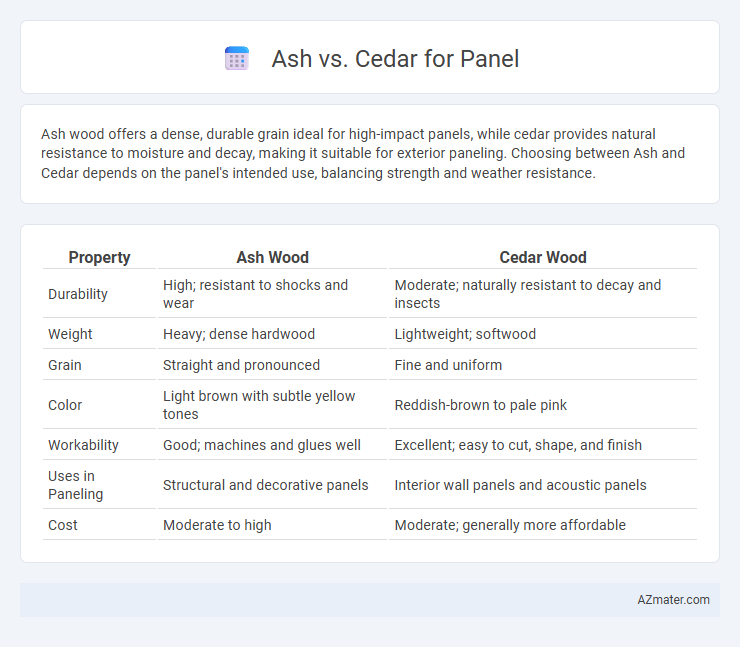Ash wood offers a dense, durable grain ideal for high-impact panels, while cedar provides natural resistance to moisture and decay, making it suitable for exterior paneling. Choosing between Ash and Cedar depends on the panel's intended use, balancing strength and weather resistance.
Table of Comparison
| Property | Ash Wood | Cedar Wood |
|---|---|---|
| Durability | High; resistant to shocks and wear | Moderate; naturally resistant to decay and insects |
| Weight | Heavy; dense hardwood | Lightweight; softwood |
| Grain | Straight and pronounced | Fine and uniform |
| Color | Light brown with subtle yellow tones | Reddish-brown to pale pink |
| Workability | Good; machines and glues well | Excellent; easy to cut, shape, and finish |
| Uses in Paneling | Structural and decorative panels | Interior wall panels and acoustic panels |
| Cost | Moderate to high | Moderate; generally more affordable |
Introduction to Ash vs Cedar for Paneling
Ash and cedar are popular wood choices for paneling due to their durability and aesthetic appeal. Ash features a light color with a straight grain and is known for its strength and shock resistance, making it ideal for high-traffic areas. Cedar offers natural resistance to decay and insects, with a rich reddish hue and aromatic qualities that enhance indoor air quality while providing a warm, inviting atmosphere.
Wood Characteristics: Ash vs Cedar
Ash wood is known for its strength, hardness, and excellent shock resistance, making it ideal for durable panels that require wear resistance and a smooth finish. Cedar offers natural decay resistance, lightweight properties, and a distinct aromatic scent, with a rich reddish-brown color that enhances aesthetic appeal in interior or exterior paneling. The open grain of ash provides a pronounced texture, while cedar's fine, straight grain delivers a softer, more uniform surface, influencing both durability and visual effect in panel applications.
Durability and Longevity Comparison
Ash wood offers superior durability and shock resistance, making it ideal for high-traffic panel applications where strength is essential. Cedar provides excellent natural decay resistance and stability due to its natural oils, ensuring longevity in moisture-prone environments. While ash excels in hardness and impact resistance, cedar outperforms in rot resistance and weather endurance, influencing panel lifespan based on exposure conditions.
Aesthetic Appeal: Grain and Color Differences
Ash panels showcase a distinctive grain pattern characterized by straight, prominent lines and a light beige to pale brown color, offering a clean, modern aesthetic that enhances contemporary interiors. Cedar panels feature a warmer, reddish-brown tone with tight, fine grain and natural knots that add rustic charm and visual texture, ideal for cozy or traditional settings. The contrasting grain prominence and color warmth between ash and cedar make them suited to different design preferences, with ash leaning toward sleek uniformity and cedar providing rich, organic character.
Resistance to Moisture and Decay
Ash offers moderate resistance to moisture and decay, making it suitable for indoor paneling but requiring proper sealing when exposed to damp conditions. Cedar demonstrates superior natural resistance to moisture and decay due to its inherent oils and tight grain structure, making it ideal for both indoor and outdoor panels in humid or wet environments. Choosing cedar over ash for paneling ensures greater durability and longevity in moisture-prone areas.
Workability and Installation Ease
Ash offers excellent workability due to its fine grain and moderate hardness, making it easy to cut, shape, and sand for paneling projects. Cedar, while softer and lighter, provides easier installation because it resists splitting and is naturally rot-resistant, reducing the need for extensive sealing or treatment. Both woods excel in panel applications, but ash suits detailed craftsmanship while cedar speeds up installation with durability and low maintenance.
Environmental Impact and Sustainability
Ash panels offer a more sustainable option due to their faster growth rates and widespread availability, resulting in lower environmental impact through reduced deforestation. Cedar panels, while naturally resistant to decay and pests, come from slower-growing trees often harvested from limited regions, leading to higher ecological footprints and concerns over habitat disruption. Choosing ash over cedar for paneling supports better forest management practices and decreases carbon emissions associated with wood harvesting and transportation.
Cost Analysis: Ash vs Cedar
Ash panels typically cost between $4 to $7 per square foot, offering a durable and affordable option with excellent shock resistance. Cedar panels range from $6 to $10 per square foot, valued for natural rot resistance and aesthetic appeal but generally pricier due to their premium qualities. When considering long-term value, ash provides greater durability at a lower initial cost, whereas cedar's higher upfront price reflects its enhanced weather resistance and lower maintenance needs.
Maintenance and Care Requirements
Ash wood panels demand regular sealing and occasional sanding to maintain their durability and resistance to moisture, preventing warping and cracking. Cedar panels, naturally rich in oils, require less frequent sealing but benefit from periodic cleaning and application of UV-protective finishes to preserve their weather resistance and color. Both woods thrive with prompt attention to spills and environmental exposure, but cedar's inherent decay resistance reduces overall maintenance efforts compared to ash.
Best Applications: Choosing Ash or Cedar Panels
Ash wood panels offer exceptional durability and a light, consistent grain ideal for flooring and furniture that demand strength and aesthetic appeal. Cedar panels excel in outdoor applications due to their natural resistance to moisture, decay, and insects, making them perfect for siding, decking, and garden structures. Selecting ash or cedar depends on the environment and use; ash suits interior projects needing hardness and smooth finish, while cedar is preferred for exterior uses requiring weather resistance and aromatic properties.

Infographic: Ash vs Cedar for Panel
 azmater.com
azmater.com